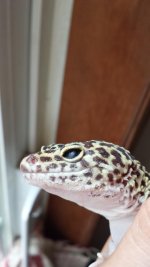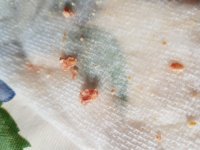Basic Information
Species of lizard: Leopard Gecko
Gecko's name: Gizmo
Morph:
Gender: Male
Age: ~5 (got him as a baby)
Weight: 55-60g
Enclosure dimensions (length x width x height): 24X12X12 (he was living in a 30x12x12 until he got sick)
Substrate provided: reptile carpet
Do not record temperature
Insects and worms, list type: crickets, mealworms, waxworms
Regular diet fed to the insects: carrots
Regular diet fed to the worms: carrots
How often do you feed your gecko? Try for 3x per week
Please list any supplements (with brand names) used. How are they given and how often?
If your gecko is sick, please describe the signs and how long your gecko has been showing these signs:
August 2016 I began to notice that something didn’t seem right with Gizmo. I began noticing what I believed to be mouth rot and an eye infection in his left eye. His left eye appeared cloudy and around his mouth appeared to be infected (could see some tissue/scabbing/teeth falling out). At this point he stopped eating, but weighed ~70g. I began documenting with pictures. It is also probably a good idea to mention that Gizmo is a very “chill” leo and has no problem being handled- he has always been like that, so it wasn’t a struggle or stress on him to get pictures.
I began to make an appointment at the nearest exotic vet in my area. One of days prior the appointment I picked him up and noticed right away he has a white cloudy watery discharge out of his left eye, with a tinge of red (like a little droplet of water sitting on his closed eye). The vet suggested that he could have an abscessed eye that had ruptured. She was unable to determine if his eye was still intact or has ruptured. She gave me an antibiotic drop for his eye and an oral antibiotic for his mouth.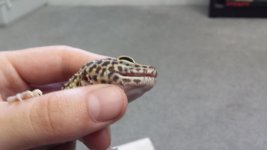

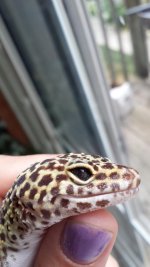

We did the antibiotic treatments and his mouth rot seemed to completely go away and I could see now that his eyeball had not ruptured, and his eye seemed to improve as well. But it never went back to normal and I do not believe he has any vision out of his left eye (appeared dry, scratchy, and reflected a dark blue colour), I just thought that’s how it healed from whatever infection he had, and I’m lucky he made it. He began to eat again, everything seemed dandy with my one-eyed guy! My vet continued contact with me through email. Everything seemed well.
Then I began noticing these, what I describe as, ‘white tissue growths’ in the both hinges of his jaw- just below his eyes - my vet had no clue what these were and began research, but she never got down to an answer. At this point I was not sure if the white tissue growths were related to the issue with his eye (because there were two white tissue growths, one on both sides of his head…but only his left eye was effected). These things appeared to stay the same size for months.
- my vet had no clue what these were and began research, but she never got down to an answer. At this point I was not sure if the white tissue growths were related to the issue with his eye (because there were two white tissue growths, one on both sides of his head…but only his left eye was effected). These things appeared to stay the same size for months.
Then I began noticing the left eye start developing this, what I called, “white film” that would kind of flake off, if rubbed by a wet cotton swab across it… but even with flushing the eye with water the eye remained cloudy with a layer of this white film
that would kind of flake off, if rubbed by a wet cotton swab across it… but even with flushing the eye with water the eye remained cloudy with a layer of this white film 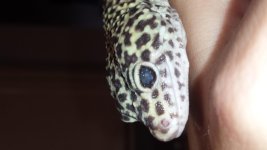 . The tissue in the hinges of his jaw remained the same size for months and the mouth rot along his mouth, never returned. One day I was looking at his mouth and was using a wet cotton swab to help open his mouth and one of the white tissue grows popped right out of his jaw/cheek right in front of me. It was a solid chunk, brownish-white in colour, and a little spongy. I was relieved.. thinking whatever was going on has stopped and these things are maybe drying up and falling out!
. The tissue in the hinges of his jaw remained the same size for months and the mouth rot along his mouth, never returned. One day I was looking at his mouth and was using a wet cotton swab to help open his mouth and one of the white tissue grows popped right out of his jaw/cheek right in front of me. It was a solid chunk, brownish-white in colour, and a little spongy. I was relieved.. thinking whatever was going on has stopped and these things are maybe drying up and falling out!
Fast forward 2 months and now the white tissue growths in his cheeks are growing big and now the RIGHT side is putting pressure into his eye socket making it so that he cannot see out of it (I think these two issues are related now..). His right eye is now also showing small amounts of the white film on the left eye. He has stopped eating, I imagine not being able to see out of either eyes is stressing and it may be painful to eat now. He is a lot smaller than he used to be, I think he’s just on the verge of being sickly skinny, but OK for now. Pictures to come!
Vet in the beginning suggested that it could be retained skin, abscessed eye, eye injury from food, etc. etc. Then I mentioned Vitamin A deficiency possibly? And she wasn’t sure and was going to find out for me. I did some research and decided to switch him to Zoo Med Reptivite with D3 for dusting food and Zoo Med Calcium without D3 always in his tank. I didn’t notice any changes in his health.
I’m basically hoping someone has seen this before and can tell me what it is so I can tell my vet ☹
Species of lizard: Leopard Gecko
Gecko's name: Gizmo
Morph:
Gender: Male
Age: ~5 (got him as a baby)
Weight: 55-60g
Enclosure dimensions (length x width x height): 24X12X12 (he was living in a 30x12x12 until he got sick)
Substrate provided: reptile carpet
Do not record temperature
Insects and worms, list type: crickets, mealworms, waxworms
Regular diet fed to the insects: carrots
Regular diet fed to the worms: carrots
How often do you feed your gecko? Try for 3x per week
Please list any supplements (with brand names) used. How are they given and how often?
If your gecko is sick, please describe the signs and how long your gecko has been showing these signs:
August 2016 I began to notice that something didn’t seem right with Gizmo. I began noticing what I believed to be mouth rot and an eye infection in his left eye. His left eye appeared cloudy and around his mouth appeared to be infected (could see some tissue/scabbing/teeth falling out). At this point he stopped eating, but weighed ~70g. I began documenting with pictures. It is also probably a good idea to mention that Gizmo is a very “chill” leo and has no problem being handled- he has always been like that, so it wasn’t a struggle or stress on him to get pictures.
I began to make an appointment at the nearest exotic vet in my area. One of days prior the appointment I picked him up and noticed right away he has a white cloudy watery discharge out of his left eye, with a tinge of red (like a little droplet of water sitting on his closed eye). The vet suggested that he could have an abscessed eye that had ruptured. She was unable to determine if his eye was still intact or has ruptured. She gave me an antibiotic drop for his eye and an oral antibiotic for his mouth.




We did the antibiotic treatments and his mouth rot seemed to completely go away and I could see now that his eyeball had not ruptured, and his eye seemed to improve as well. But it never went back to normal and I do not believe he has any vision out of his left eye (appeared dry, scratchy, and reflected a dark blue colour), I just thought that’s how it healed from whatever infection he had, and I’m lucky he made it. He began to eat again, everything seemed dandy with my one-eyed guy! My vet continued contact with me through email. Everything seemed well.
Then I began noticing these, what I describe as, ‘white tissue growths’ in the both hinges of his jaw- just below his eyes
 - my vet had no clue what these were and began research, but she never got down to an answer. At this point I was not sure if the white tissue growths were related to the issue with his eye (because there were two white tissue growths, one on both sides of his head…but only his left eye was effected). These things appeared to stay the same size for months.
- my vet had no clue what these were and began research, but she never got down to an answer. At this point I was not sure if the white tissue growths were related to the issue with his eye (because there were two white tissue growths, one on both sides of his head…but only his left eye was effected). These things appeared to stay the same size for months.Then I began noticing the left eye start developing this, what I called, “white film”
 that would kind of flake off, if rubbed by a wet cotton swab across it… but even with flushing the eye with water the eye remained cloudy with a layer of this white film
that would kind of flake off, if rubbed by a wet cotton swab across it… but even with flushing the eye with water the eye remained cloudy with a layer of this white film  . The tissue in the hinges of his jaw remained the same size for months and the mouth rot along his mouth, never returned. One day I was looking at his mouth and was using a wet cotton swab to help open his mouth and one of the white tissue grows popped right out of his jaw/cheek right in front of me. It was a solid chunk, brownish-white in colour, and a little spongy. I was relieved.. thinking whatever was going on has stopped and these things are maybe drying up and falling out!
. The tissue in the hinges of his jaw remained the same size for months and the mouth rot along his mouth, never returned. One day I was looking at his mouth and was using a wet cotton swab to help open his mouth and one of the white tissue grows popped right out of his jaw/cheek right in front of me. It was a solid chunk, brownish-white in colour, and a little spongy. I was relieved.. thinking whatever was going on has stopped and these things are maybe drying up and falling out! Fast forward 2 months and now the white tissue growths in his cheeks are growing big and now the RIGHT side is putting pressure into his eye socket making it so that he cannot see out of it (I think these two issues are related now..). His right eye is now also showing small amounts of the white film on the left eye. He has stopped eating, I imagine not being able to see out of either eyes is stressing and it may be painful to eat now. He is a lot smaller than he used to be, I think he’s just on the verge of being sickly skinny, but OK for now. Pictures to come!
Vet in the beginning suggested that it could be retained skin, abscessed eye, eye injury from food, etc. etc. Then I mentioned Vitamin A deficiency possibly? And she wasn’t sure and was going to find out for me. I did some research and decided to switch him to Zoo Med Reptivite with D3 for dusting food and Zoo Med Calcium without D3 always in his tank. I didn’t notice any changes in his health.
I’m basically hoping someone has seen this before and can tell me what it is so I can tell my vet ☹


